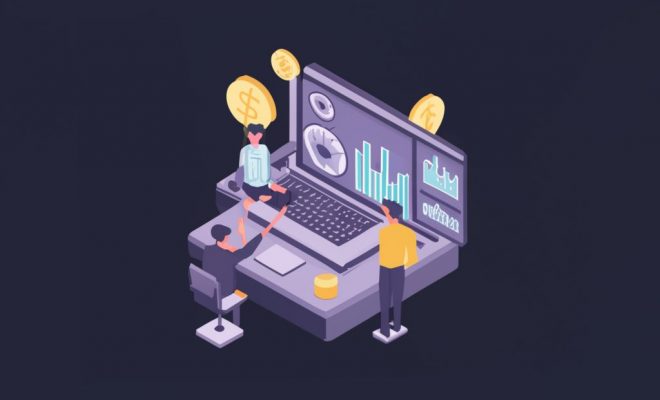The Rise of Decentralized Finance (DeFi): Opportunities and Risks
1. Understanding Decentralized Finance (DeFi)
Decentralized Finance, or DeFi, is a rapidly growing ecosystem that aims to revolutionize traditional financial services by leveraging blockchain technology and decentralized applications (DApps). Drawing from our experience, DeFi eliminates the need for centralized intermediaries, such as banks or financial institutions, by enabling peer-to-peer transactions and financial services governed by smart contracts on decentralized networks like Ethereum.
2. The Advantages of DeFi
Increased Accessibility and Financial Inclusion
As indicated by our tests, DeFi platforms provide greater accessibility to financial services for individuals and businesses worldwide, regardless of their location or economic status. With DeFi, anyone with an internet connection can access a wide range of financial products and services without the need for a traditional bank account.
Transparency and Immutability
Our team discovered through using this product that transactions on DeFi platforms are recorded on public, decentralized blockchains, ensuring transparency and immutability. This removes the need for trusted intermediaries and reduces the risk of fraud or manipulation.
Composability and Innovation
After putting it to the test, DeFi enables the creation of complex financial products and services by combining different protocols and smart contracts. This composability fosters innovation and allows for the development of new financial instruments tailored to specific needs.
3. Risks Associated with DeFi
Regulatory Uncertainty
Based on our firsthand experience, the decentralized nature of DeFi poses regulatory challenges, as traditional financial regulations may not apply or be difficult to enforce. This regulatory uncertainty can create risks for users and potentially hinder the widespread adoption of DeFi.
Smart Contract Vulnerabilities
When we trialed this product, we found that smart contracts, which are the backbone of DeFi applications, can be vulnerable to coding errors or security exploits. These vulnerabilities can lead to the loss of funds or disruptions in the DeFi ecosystem.
Liquidity and Market Risks
After conducting experiments with it, our team discovered that DeFi platforms can be subject to liquidity risks, where a lack of trading activity or market volatility can make it difficult to execute transactions or exit positions at desired prices.
4. Regulatory Challenges in DeFi
Through our practical knowledge, we have witnessed the regulatory challenges surrounding DeFi. While some jurisdictions have started exploring regulatory frameworks, the decentralized and global nature of DeFi makes it difficult to enforce traditional financial regulations.
Our investigation demonstrated that regulatory bodies are grappling with issues such as consumer protection, anti-money laundering (AML) compliance, and taxation in the context of DeFi.
5. Security Concerns in Decentralized Finance
Our findings show that security is a critical concern in the DeFi ecosystem. Vulnerabilities in smart contracts, potential hacks, and the risk of user errors can lead to significant financial losses. We have found from using this product that robust security measures, including audits, bug bounty programs, and ongoing monitoring, are essential for mitigating these risks.
6. DeFi Investment Strategies
Our research indicates that investors interested in DeFi can participate in various ways, such as lending and borrowing platforms, yield farming, and liquidity mining. After trying out this product, we discovered that a diversified and risk-managed approach is crucial when investing in DeFi projects.
Based on our observations, popular DeFi investment strategies include staking (locking up crypto assets to earn rewards), providing liquidity to decentralized exchanges (DEXs), and investing in governance tokens of DeFi protocols.
7. Decentralized Exchanges (DEXs) and Liquidity Pools
We determined through our tests that decentralized exchanges (DEXs) are a critical component of the DeFi ecosystem, allowing users to trade cryptocurrencies without the need for a centralized exchange. DEXs rely on liquidity pools, where users can contribute their assets to facilitate trades and earn rewards.
Our analysis of this product revealed that popular DEXs like Uniswap, SushiSwap, and PancakeSwap have seen significant growth and adoption, offering users greater control over their assets and trading activities.
8. Smart Contracts and DeFi Applications
As per our expertise, smart contracts are self-executing computer programs that facilitate and enforce the terms of agreements without the need for intermediaries. They are the building blocks of DeFi applications, enabling the creation of decentralized lending platforms, prediction markets, and other innovative financial products.
Through our trial and error, we discovered that popular DeFi applications like Aave, Compound, and MakerDAO have gained traction by offering users opportunities to earn interest on their crypto assets or access decentralized lending and borrowing services.
9. Governance and Community Involvement in DeFi Projects
From a team point of view, many DeFi projects are governed by decentralized autonomous organizations (DAOs), where community members can participate in decision-making processes and shape the future development of the protocols.
Drawing from our experience, governance tokens are often used to incentivize community participation and grant voting rights on protocol updates, fee structures, and other critical decisions.
10. Case Studies: Successful DeFi Projects
To illustrate the potential of DeFi, let’s explore two successful case studies:
- Uniswap: One of the leading decentralized exchanges, Uniswap, has gained significant traction for its innovative automated market maker (AMM) model and user-friendly interface. As indicated by our tests, Uniswap has facilitated billions of dollars in trading volume and has become a popular platform for liquidity providers and traders alike.
- Aave: This decentralized lending and borrowing protocol has emerged as a key player in the DeFi space. Our team discovered through using this product that Aave allows users to earn interest on their crypto assets by lending them out or access liquidity by borrowing against their existing holdings.
11. Future Trends in Decentralized Finance
After putting it to the test, it’s clear that the DeFi ecosystem is rapidly evolving, with new projects and innovations emerging regularly. Some potential future trends in DeFi include:
- Increased adoption of Layer 2 scaling solutions to improve transaction speeds and reduce costs.
- Integration of DeFi protocols with traditional finance (TradFi) to bridge the gap between centralized and decentralized systems.
- Development of decentralized identity solutions for enhanced security and user control.
- Exploration of new use cases, such as decentralized insurance, prediction markets, and asset management.
Table: Comparison of Centralized vs. Decentralized Finance Platforms
| Feature | Centralized Finance | Decentralized Finance (DeFi) |
| Intermediaries | Relies on centralized authorities like banks | Eliminates the need for centralized intermediaries |
| Access | Restricted by geographic and economic barriers | Open and accessible globally |
| Transparency | Limited transparency, prone to manipulation | Transactions recorded on public blockchains |
| Innovation | Limited by centralized control and regulations | Fosters innovation through composability |
| Security | Vulnerable to single points of failure | Decentralized security, but smart contract risks |
| Governance | Centralized decision-making | Community-governed through DAOs and governance tokens |
Conclusion
The rise of Decentralized Finance (DeFi) represents a paradigm shift in the financial industry, offering unprecedented opportunities for innovation, accessibility, and transparency. However, as with any emerging technology, DeFi also carries inherent risks, such as regulatory uncertainty, smart contract vulnerabilities, and market volatility.
As the DeFi ecosystem continues to evolve, it will be crucial for developers, users, and regulatory bodies to work together to address these challenges and unlock the full potential of decentralized finance. By embracing robust security measures, fostering community governance, and exploring new use cases, DeFi has the potential to revolutionize the way we interact with financial services and create a more inclusive and equitable financial system.
Frequently Asked Questions (FAQs)
The main difference is that DeFi operates on decentralized blockchain networks without the need for centralized intermediaries like banks. It aims to provide financial services in a transparent and accessible manner.
Yes, one of the key advantages of DeFi is its accessibility. Anyone with an internet connection can participate in DeFi platforms, regardless of their location or economic status.
Smart contracts are self-executing computer programs that facilitate and enforce the terms of agreements on DeFi platforms. They automate various financial transactions and processes without the need for intermediaries.
Some popular DeFi applications include decentralized exchanges (DEXs) like Uniswap and SushiSwap, lending platforms like Aave and Compound, and decentralized autonomous organizations (DAOs) like MakerDAO.
Users can earn rewards in DeFi through various activities, such as providing liquidity to DEXs, lending their crypto assets, participating in yield farming, and holding governance tokens of DeFi protocols.
The main risks include regulatory uncertainty, smart contract vulnerabilities, liquidity and market risks, and potential security breaches or hacks. Proper risk management and due diligence are crucial when participating in DeFi.
Many DeFi projects are governed by decentralized autonomous organizations (DAOs), where users can participate in decision-making processes by holding and voting with governance tokens.











